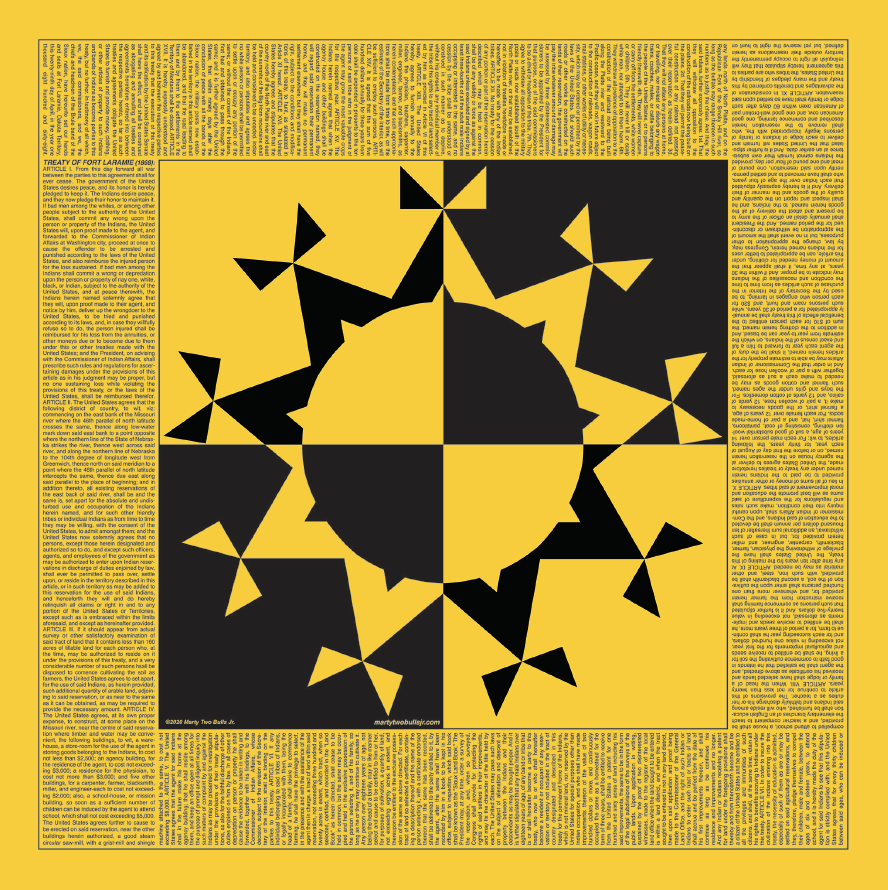Marty Two Bulls Jr.:
Lakota Quarantine Bandana, 2020
digital print
courtesy of the artist
resources:
artist site
Interview, Mni Luzahan Radio Hour, KILI radio
“Ceramic Buffaloes, Milk Jugs, and Old Medicine Cabinets,” First Peoples Fund
5 Plain Questions podcast feature:

“As an artist who shows in galleries and museums, something I always struggle with – when I work with non-Native curators or academics – is that one of the first things they will do when they see my work, because I am not working with what they consider traditional materials, is that they recategorize it as contemporary work, whereas there are artists my age who are beading or working with porcupine quills, and that same curator will relegate that to traditional,” Marty Two Bulls Jr. shared on KILI Radio’s Mni Luzahan Radio Hour. “I don’t think that’s a decision or a separation that a non-Native curator or academic should be able to make. I think it should be up to us to decide what is traditional, what’s contemporary, and how this stuff is connected, and how it is different.”Across a wide body of interdisciplinary work that includes painting, ceramics, printmaking, sculpture, and mixed-media assemblages, Marty Two Bulls Jr. creates opportunities for aesthetic encounters that leverage material and image toward sustained engagement with the historical, political, and economic forces that shape the boundaries of cultural understanding. As the founder of the Graphic Arts Program at Oglala Lakota College, these are artistic aims that he also inspires the next generation of artists from his community to meet. In the midst of a successful career that has seen his work featured in exhibitions and museum collections around the world, Two Bull Jr.’s most recent project dwells upon notions of accessibility alongside questions of visual and narrative sovereignty that draw from, and honor, generational knowledge while cultivating an innovative design sense.
Lakota Quarantine Bandana is at once a direct and multilayered object of support within his Oglala Sioux community, as the Tribe has closed the Pine Ridge Indian Reservation to outsiders in an effort to protect its citizens, and particular its more vulnerable elders, from the COVID-19 pandemic. “Lakota Culture is rooted in an oral tradition,” Two Bulls Jr. writes. “Our elders are our connection to our past, they ground us in our present, and guide us into our future. Because elders have the highest risk of infection and death from the virus, the pandemic has become a threat to the survival of Lakota Culture.”
The imperative for such a decision by the Oglala Sioux Tribe is also a reflection of the realities of how the virus – due to pervasive, generational inequities in funding and social services – disproportionately affects communities in Indian Country, with recent data from the Centers for Disease Control and Prevention sharing that Native individuals are more than 3.5 times more likely to be diagnosed with COVID-19 than the “non-hispanic white population.” In the midst of the Oglala Sioux Tribe safeguarding its borders, South Dakota Governor Kristi Noem has threatened to remove COVID-19 relief aid and terminate law enforcement contracts, unless these checkpoints are removed.
The black and yellow design at the center of the Lakota Quarantine Bandana communicates the international symbol for quarantine within the flag of the Oglala Sioux Tribe, and this image is itself bordered by the full text of the 1868 Fort Laramie Treaty – an agreement that, although broken by the United States government, establishes the clear legal statement of tribal sovereignty. Marty Two Bulls Jr.’s design, and also the direct utilitarian nature of its material, has created a range of applications for the Bandana within this moment – as a facemask, a teaching tool, a handkerchief, and a flag to mark the quarantined border.
︎︎︎return to exhibition artists
︎︎︎further information at Plains Art Museum